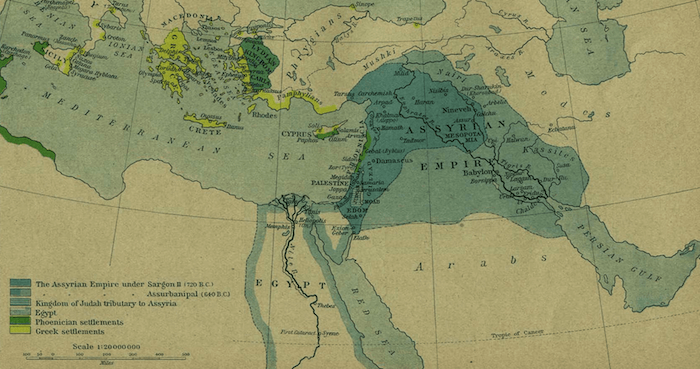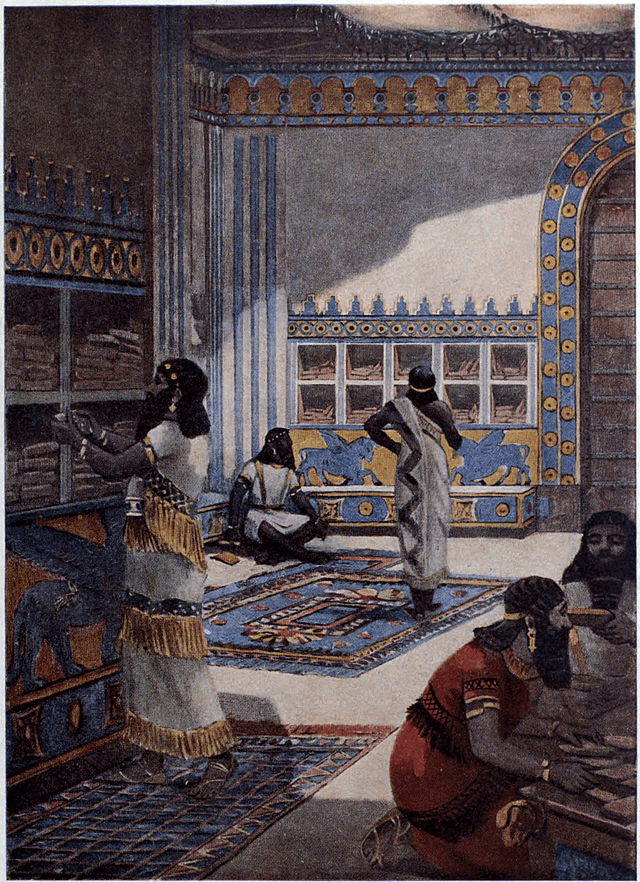People > Ashurbanipal
Ashurbanipal
Background
Ashurbanipal (668-627 BC) was the last great king of the ancient empire of Assyria. He was the son of Esarhaddon and the grandson of Sennacherib. He is well known for being the most intellectual of the great kings and established the Library of Ashurbanipal where we get much of what we know about the Assyrians today. Much of this collection is currently housed at the British Museum and allows scholars and historians to have a better picture of not just Assyria but other cultures of Mesopotamia as well.
Under Ashurbanipal the civilization of Assyria would expand to its greatest heights, encompassing an area from the Mediterranean Sea in the west to the Iranian Plateau in the east, the Caucus Mountains to the north and as far south as Nubia in northern Africa. The Assyrians were the first true ancient superpower and established one of the greatest and most powerful ancient empires. They were universally hated by their conquered populations and this led to quick revolts upon the death of very powerful kings.
Upon the death of Ashurbanipal the civilization of Assyria would be wrecked by internal civil wars which created political and social strife that allowed oppressed vassal states to siege the inner-most cities of the empire. Ashurbanipal's successors were unable to hold onto the massive amount of territory held and it all began to unravel. Eventually the whole civilization would be assimilated by neighboring Babylonia with a unique blending of the cultures that allowed it to persist into the modern day.
Early Life
During his early life Ashurbanipal was made the successor Esarhaddon. He grew up in the small palace known as bit reduti or the house of succession that was built by Sennacherib in northern quadrant of the capital Nineveh. This was the house of his father who inherited it after Sennacherib built the Palace Without Rival in the southwestern corner. It was in this smaller palace that Sennacherib would be assassinated by the uncles of Ashurbanipal which would force Esarhaddon to return and avenge his death.
Known only as Adrammelech and Sharezer from the Biblical account Esarhaddon crushed the rebels and executed all the supporters and their families in 681 BC. Following this event the smaller palace was given to Ashurbanipal and his mother along with Esarhaddon's other children. For himself he rebuilt the bit masharti or the weapons house as his residence. Ashurbanipal had five brothers and one sister that are known, including Sin-iddin-apli who was initially supposed to be heir to the throne but died in 672 BC.
Since Ashurbanipal was never expected to take the throne he was trained in all sorts of academic subjects along with learning how to hunt, ride horses, chariots and be a great soldier. In his own autobiography he describes how he learned oil divination, mathematics, reading and writing as a kid and is known to possibly be the only Assyrian king that knew who to read or write.
Becoming King
When Esarhaddon's first wife died in 672 BC his mother helped organize a treaty with the Medes in order to guarantee Ashurbanipal's right to rule. This worked because Media was a vassal state to Assyria and made sure Ashurbanipal would rule over Assyria and Shamash-shum-ukin over Babylonia. Esarhaddon constructed a massive stele that showed himself and his two sons on either side, hoping they would achieve a dual monarchy over the kingdom.
Esarhaddon would die suddenly while planning an expedition to Egypt in 669 BC and the two sons ascended to the throne within a few months. Right away his grandmother Naqia/Zakutu made sure any reports of treason were brought directly to them in order to make sure the dynasty continued.
Ashurbanipal was officially made king in 668 BC and was officially coronated in the traditional Assyrian custom during the second month of that year. He made his brother the king of Babylon and the two practiced a form of dual monarchy for the early years of Ashurbanipal's rule. However, Ashurbanipal would have supreme rule of Assyria and Babylonia and this would bring about conflicts in the future as ruling over Babylon always seemed to inspire some sense of drive for independence.
While known for being a fair, just, literate and effective leader he still had a cruel streak.
Egypt Campaign
See Egypt Campaign
Elam Campaign
See Elam Campaign
Babylonian Revolt
Following the conquest of Babylonia the Assyrian Empire came to grow to its largest extent. This is a list of all the peoples and civilizations that were part of this massive political entity.

Assyrian Empire Map (750-625 BC) - Historical Atlas (1923)
- Arabia
- Aram
- Armenia
- Babylonia
- Caria
- Chaldea
- Cilicia
- Cimmeria
- Commagene
- Corduene
- Cyprus
- Dilmun
- Edom
- Egypt
- Elam
- Gutium
- Hittites
- Kingdom of Israel
- Kingdom of Judah
- Lydia
- Manneaans
- Media
- Moab
- Nabataeans
- Nubia
- Persia
- Phoenicia
- Samarra
- Phrygia
- Scythia
- Urartu
As you can see this is a considerable amount and there were several forced relocations of people. Just like under the similar Achaemenid Empire there is a great consolidation of power and territory. This often meant the demise and collapse of specific independent civilizations for good who may never exert regional sovereignty again. For the rest of history they may only exist as vassal states or territories that are governed by larger empires.
Some populations may be relocated to the capital or a vacant area of the empire and thus their territory can be inhabited by a different group. This movement of people is key to understanding ancient history and the various interactions between all the disparate civilizations of the planet.
Library of Ashurbanipal
One of the greatest achievements of Ashurbanipal was his development of the Library of Ashurbanipal that was built within the palace complex at the city of Nineveh. This great library held many clay cuneiform tablets that recorded all aspects of Assyrian life and history. When the city of Nineveh was sieged the palace complex was burnt to the ground and the entire city razed. Nineveh was then abandoned and never occupied again which led to immaculate preservation of the tablets.
While papyrus books or scrolls would have been consumed by the fire the clay tablets simply got baked harder which preserved them even better. When the library was uncovered by archaeologists at the ruins of Nineveh it was a treasure trove of Assyrian history that let early archaeologists have a great view of the past. In addition the sources from this library allow us to corroborate claims made in other sources throughout the ancient world and help us gain a better understanding of the various interactions between civilizations.

Library of Ashurbanipal - Story of the Nations (1915)
The library of Ashurbanipal was very well preserved and a significant percentage of the total content survives into the present day. Due to the nature of the writing medium the ancient clay tablets are probably one of the best methods for recording data for long term storage in history as they are much less subject to destruction than papyrus, parchment or paper.
The achievements of Ashurbanipal reflect his intellectual and literate nature and have been extremely beneficial to mankind in general. The development of intellectual achievement and libraries usually coincides with golden ages and Ashurbanipal definitely presided over one.
Death
Ashurbanipal died in the 42nd year of his reign in 627 BC and was succeeded by Ashur-etli-ilani (626–623 BC) who was able to rule for three years before Assyria descended into civil war. There is not much record from this period and what we do know is based on the Greek historian named Castor.